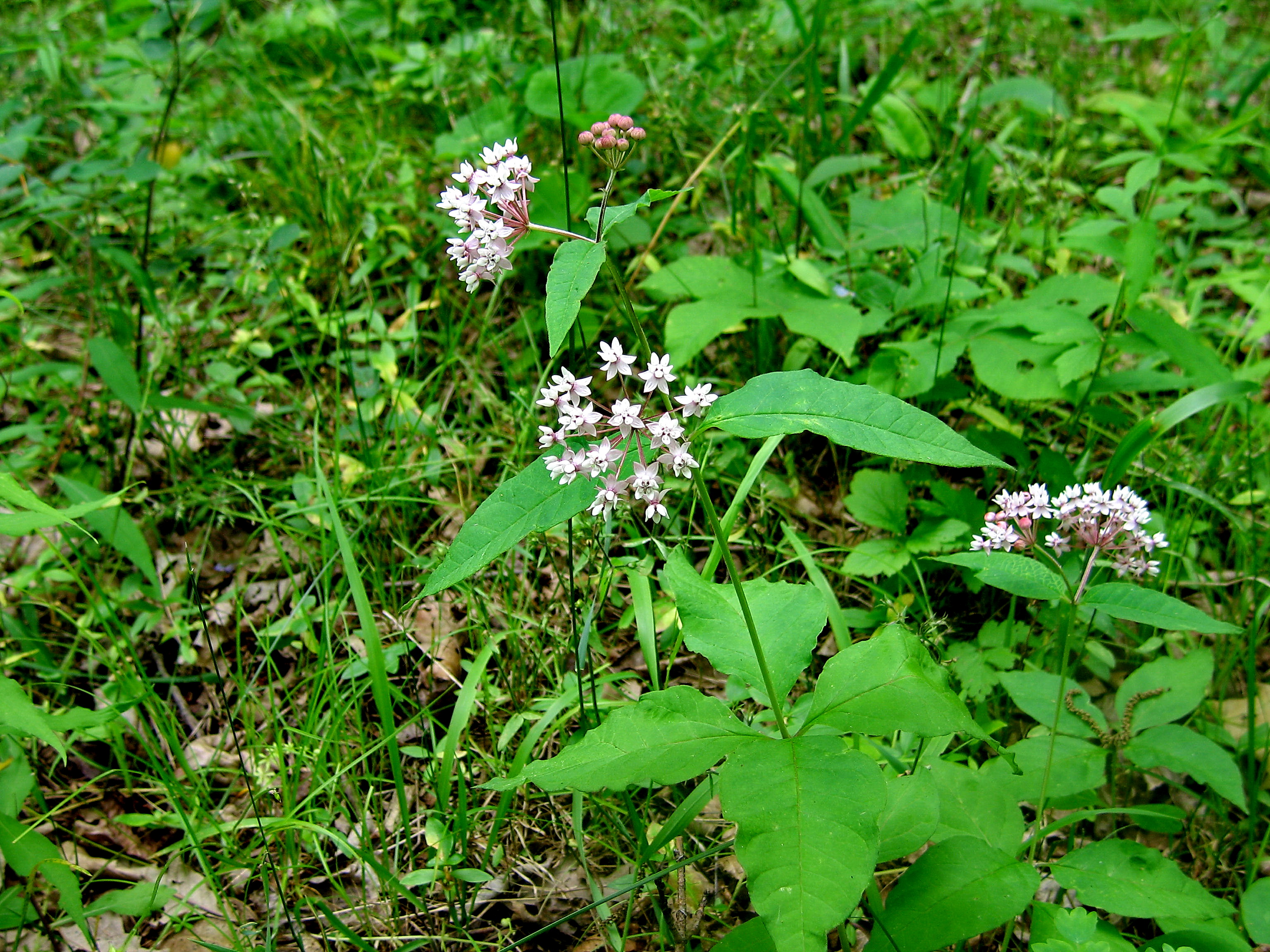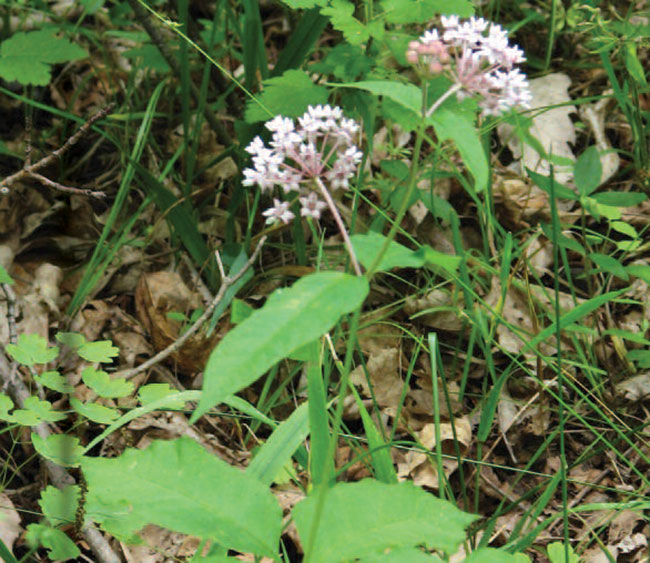Four-leaved Milkweed

Species information
This chapter provides a review of progress towards the protection and recovery of Four-leaved Milkweed in Ontario from 2007 to 2016.
Four-leaved Milkweed (Asclepias quadrifolia) is an herbaceous perennial plant in the milkweed family. The flowers are in one to four clusters of 10 to 25 pinkish-white flowers. The species is pollinated by insects and seeds are likely wind dispersed. The species occurs throughout the northeastern United States and is currently known to occur at two sites in Ontario, both in Prince Edward County in the Bay of Quinte area. The species has not been rediscovered at any of its historic sites including locations in the Niagara Region and Lennox-Addington County. In Ontario, the two extant populations occur on dry alvar-type sites, with thin soils underlain by limestone and tree species that include Bur Oak (Quercus macrocarpa), Shagbark Hickory (Carya ovata) and Northern Prickly Ash (Zanthoxylum americanum). This habitat type is extremely rare in Ontario and is ranked as critically imperilled by the Ontario Natural Heritage Information Centre.
At the two sites where it is known to occur in Ontario, Four-leaved Milkweed faces several threats to its survival and recovery including: habitat loss from agriculture and residential land uses; habitat loss and degradation from natural succession of woody vegetation and invasive plant species; and trampling caused by human activities such as all-terrain vehicle use and hiking.
The survival and recovery of Four-leaved Milkweed are influenced by other factors as well. The species is at the northern limit of its range in North America and may have always been rare in Ontario.
Four-leaved Milkweed is listed as endangered at the provincial level (Species at Risk in Ontario List); it is not listed under the federal Species at Risk Act. Globally, it is considered to be secure (NatureServe).
Provincial status
The Committee on the Status of Species at Risk in Ontario (COSSARO) assessed Four-leaved Milkweed as endangered. As a result, it was added to the Species at Risk in Ontario List under the Endangered Species Act, 2007 (ESA or “the Act”) in 2010. In future assessments, COSSARO may consider information gained through protection and recovery actions regarding the species’ threats and trends in population and distribution.
Species and habitat protection
Protecting Four-leaved Milkweed and its habitat are key components in the implementation of the ESA, and continue to be government-led actions, as identified in the government response statement. As an endangered species, Four-leaved Milkweed has been protected from being killed, harmed, harassed, captured or taken under the ESA since it was listed in 2010. In addition, the species’ habitat has been protected from being damaged or destroyed since 2010. Habitat protection for the species was initially based on the general habitat definition in the ESA. The habitat of Four-leaved Milkweed is now protected through a habitat regulation that came into force in 2014.
The government developed the habitat regulation (Ontario Regulation 242/08, section 27.0.1) for Four-leaved Milkweed. The habitat regulation provides clarity to the public and others on what areas are protected as Four-leaved Milkweed habitat. The regulated habitat includes areas that are required by the species to carry out its life processes (e.g., respiration, growth, reproduction) within its range in Ontario. The habitat regulation was developed based on information about the habitat needs of the species as well as social and economic factors, collected from a variety of sources including comments received through public consultation.
Any person who negatively impacts Four-leaved Milkweed or its habitat without prior authorization may be prosecuted under the ESA.
Four-leaved Milkweed has been protected from being killed, harmed, harassed, captured or taken since 2010.
In addition, the habitat of Four-leaved Milkweed has been protected from being damaged or destroyed since 2010. Habitat protection was initially based on the general habitat definition in the ESA. The habitat of Four-leaved Milkweed is now protected through a habitat regulation that came into force in 2014.
Recovery strategy
A recovery strategy for Four-leaved Milkweed was published on December 7, 2011. Recovery strategies are advice to government and represent the best available scientific knowledge. The strategy identifies the habitat needs of Four-leaved Milkweed and the threats that it faces, while recommending objectives and approaches for protecting and recovering the species. The recovery strategy also includes recommendations on the areas of habitat to be considered in the development of a habitat regulation.
Government response statement
The Ministry of Natural Resources and Forestry (“the Ministry”) published the government response statement (GRS) for Four-leaved Milkweed on September 7, 2012, which was within the timeframe required by the ESA. The GRS is government policy that contains the Government of Ontario’s goal for the recovery of Four-leaved Milkweed.
To help achieve this goal, the government leads and supports recovery actions identified in the GRS. Common actions for the government to lead as it works towards achieving a species’ recovery goal are provided in section 2.5 of the Species at Risk Program Status (2008-2015).
Recovery Goal
The government’s goal for the recovery of Four-leaved Milkweed is to ensure the persistence of a self-sustaining population in Ontario.
The GRS for Four-leaved Milkweed also lists three actions the Ministry supports others to undertake for the species. These government-supported actions fall under the objectives identified in the GRS, which are:
- Protect existing populations and associated habitat and mitigate threats; and
- Improve knowledge of Four-leaved Milkweed habitat, ecology, and threats.
Ontario’s Invasive Species Act
The GRS for Four-leaved Milkweed indicates that invasive species pose a threat to the survival and recovery of the species in Ontario. The Ontario Invasive Species Strategic Plan, 2012 and the provincial Invasive Species Act, 2015 provide the policy and legislative framework to support the prevention, detection and control of invasive species in Ontario. This framework may support actions to reduce the threats of invasive species on native and at-risk species, including Four-leaved Milkweed.
Supporting our partners
Supporting partners to undertake activities to protect and recover Four-leaved Milkweed through the Species at Risk Stewardship Program, as well as through permits and their associated conditions, is an important government-led action identified in the GRS for the species. To-date, no authorizations or regulatory provisions have been issued or registered for the species.
Through the Species at Risk Stewardship Program, the Ministry has supported a total of five projects designed to contribute to the protection and recovery of Four-leaved Milkweed. One of these projects ($8,650) focused exclusively on the species, while the other four projects ($93,500) focused on multiple species at risk, including Four-leaved Milkweed. In addition to the government funding, partners with projects designed to benefit multiple species at risk, including Four-leaved Milkweed, were able to secure additional funding and in-kind support ($241,805) from other sources. This amount includes additional funding and in-kind support in the form of time and expertise provided by volunteers.
Stewardship partners reported that provincial funding helped them to secure in-kind support by involving 42 individuals who volunteered 668 hours of their time toward protection and recovery activities for multiple species at risk, including Four-leaved Milkweed, which has an estimated value of $21,250.
Stewardship partners reported that, through both their efforts and the efforts of their volunteers to implement actions contained in the GRS, they were successful in enhancing 1.6 hectares of habitat that will benefit multiple species at risk, including Four-leaved Milkweed. In addition, stewardship partners reported providing focused outreach to 2,787 individuals on multiple species, including Four-leaved Milkweed.
The remainder of this section highlights two projects supported through the Species at Risk Stewardship Program as well as the corresponding government-supported recovery actions for the species.
In 2014, Dr. Jenny McCune used computer models to predict suitable habitat for eight species of rare Ontario woodland plants as part of her Postdoctoral research at the University of Guelph. The models can help to prioritize areas to search for previously unknown populations of the species. Under testing, the models effectively predicted the distributions of seven of the eight species examined, and led to the discovery of new populations of four of the species (McCune 2016). To build on this research, Dr. McCune obtained stewardship funding to develop models for 12 additional at-risk woodland species, including Four-leaved Milkweed. Using species locations as well as 14 environmental variables (e.g., precipitation, temperature, elevation, soil type, and surficial geology), Dr. McCune created a predictive map of suitable habitat for Four-leaved Milkweed. In cooperation with private landowners, field surveys were conducted at 25 woodland areas that the model predicted to contain suitable habitat for Four-leaved Milkweed, and 131 areas that were not predicted to contain suitable habitat for Four-leaved Milkweed but were predicted to be suitable for one or more other plant species-at-risk. Four-leaved Milkweed was not found in any of these areas. Nonetheless, when examining the results for all rare woodland species, the study demonstrated that species distribution models can help identify sites for rare plant surveys. Dr. McCune also developed fact sheets for landowners that contained photos of the species, a map of the area of Ontario predicted to provide the most suitable habitat, a description of the habitat, and tips on how to distinguish it from similar looking species. Interested landowners were also provided lists of all the plant species found on their property. While field searches did not locate additional Four-leaved Milkweed populations at locations predicted by the model, this study has improved our knowledge of where the species occurs and contributes to the GRS action to develop and implement a standardized survey and monitoring program by assessing habitat conditions of current populations and conducting further searches of suitable habitat for undiscovered populations.
In 2014, Canadian Wildlife Federation and consulting ecologist Holly Bickerton received funding to undertake a project dedicated to the recovery of Four-leaved Milkweed. The stewardship partners surveyed the Macaulay Mountain Conservation Area (MMCA), described and mapped occupied and suitable habitat at this site using Ecological Land Classification methods, identified and searched other areas of suitable habitat in Prince Edward County (and nearby), developed a management plan, a standardized monitoring protocol and communication materials. During surveys, Four-leaved Milkweed plants were found in two new areas within and adjacent to the MMCA, expanding our knowledge of the distribution at this site. The management plan created for Macaulay Mountain determined the primary threats to the species (invasive species and recreational trail use) and provided recommendations for monitoring and invasive species control. This project contributes to the high-priority GRS action to develop and implement best management practices for alvar woodland communities that address known and potential threats. The project has also contributed significantly to the GRS action to develop and implement a standardized survey and monitoring program by inventorying populations, assessing habitat conditions, and completing a standardized survey and monitoring protocol.
Species at Risk Stewardship Fund
-
 $8,650
$8,650for Four-leaved Milkweed exclusively
-
 $93,500
$93,500for multi-species projects that included Four-leaved Milkweed
-
 $241,805
$241,805in additional funding and in-kind support
-
 5
5projects included the Four-leaved Milkweed
-
 42
42volunteers
-
 668
668volunteer hours
-
 2,787
2,787people received outreach
-
 2
2hectares of habitat enhanced
Occurrences of Four-leaved Milkweed in Ontario
Natural Heritage Information Centre (NHIC)
Five populations
Since 2010, the Ministry’s central repository at the Natural Heritage Information Centre (NHIC) has received approximately 65 records of the species. These records are based on observations between 1868 and 2014 and come from a variety of sources. Records submitted have helped to redefine where the species is known and has been known to occur and have provided additional information on the species’ habitat and threats. No new populations of Four-leaved Milkweed have been identified since 2010; however, in 2006 and 2007, two new populations in Prince Edward County (McMahon Bluff and Macaulay Mountain Conservation Area) were discovered and subsequently reconfirmed in 2012. In 2014, two new patches were found during surveys at the Macaulay Mountain Conservation Area population by a stewardship partner during surveys funded by the Species at Risk Stewardship Fund. As such, the population viability rank was updated to good, indicating some certainty with respect to the long-term persistence of the population.
It is possible that there are observations of Four-leaved Milkweed that have not been submitted to the Ministry. Encouraging the submission of species observations to the Ministry is included in the GRS as a government-led action. Submission of species observations to the Ministry increases our knowledge of where they occur and can play an important role in assessing the viability of populations.
Everyone is encouraged, or may be required by an authorization or approval, to submit observations of the Four-leaved Milkweed, and any other species at risk observed, to the Natural Heritage Information Centre for incorporation into the provincial record of observations.
65 observations of the species were submitted to the NHIC since 2010
Summary of progress towards meeting the recovery goal
Summary of progress
Progress has been made toward all of the government-led actions and all of the government-supported actions outlined in the GRS for Four-leaved Milkweed. The Government of Ontario has directly undertaken actions to:
- Educate other agencies and authorities involved in planning and environmental assessment processes on the protection requirements under the ESA;
- Encourage the submission of Four-leaved Milkweed data to the Ministry’s central repository at the Natural Heritage Information Centre;
- Undertake communications and outreach to increase public awareness of species at risk in Ontario;
- Protect Four-leaved Milkweed and its habitat through the ESA. Develop and enforce a regulation identifying the specific habitat of the species;
- Support conservation, agency, municipal and industry partners and First Nations and Métis communities and organizations to undertake activities to protect and recover Four-leaved Milkweed. Support will be provided where appropriate through funding, agreements, permits (including conditions) and advisory services; and
- Establish and communicate annual priority actions for government support in order to encourage collaboration and reduce duplication of efforts.
Government-supported actions are organized under over-arching recovery objectives. Progress has been made toward all of the government-supported recovery objectives and all of the associated actions that are identified in the GRS for Four-leaved Milkweed.
Under the objective to protect existing populations and associated habitat and mitigate threats, initial progress has been made towards one action:
- Develop and implement best management practices for alvar woodland communities that address known and potential threats, such as habitat loss and degradation due to residential and agriculture land uses, woody species succession, and invasive species (Action No. 1; High Priority).
Initial progress toward this action has been implemented through a project supported by the Species at Risk Stewardship Program that included development of a management plan for the Macaulay Mountain population that provides guidance on how to monitor populations and reduce and manage invasive species.
Under the objective to improve knowledge of Four-leaved Milkweed habitat, ecology, and threats, progress has been made towards all of the actions:
- Develop and implement a standardized survey and monitoring program for Four-leaved Milkweed which includes:
- Conducting inventories of populations;
- Assessing habitat conditions of current populations; and
- Conducting further searches of suitable habitat for undiscovered populations (Action No. 2).
- Prioritize and undertake research to address remaining questions regarding the species’ ecology, including:
- Species demographics;
- Minimum viable population requirements; and
- Response to threats (Action No. 3).
Progress has been made toward these two actions through a project supported by the Species at Risk Stewardship Program that resulted in the development of habitat suitability models, a management plan for a conservation area and a survey and monitoring protocol. The discovery of Four-leaved Milkweed in two new areas within one of the two extant provincial populations also contributes to a better understanding of where the species is known to occur.
The recovery goal for Four-leaved Milkweed is to ensure the persistence of a self-sustaining population in Ontario. Effort made toward the government-led and government-supported GRS actions has helped make progress towards this goal. The provincial record of observations suggests that Four-leaved Milkweed is persisting in Ontario. While the viability of one of the existing populations has not been assessed, numerous stems were observed at that location in 2012. The other population (i.e., the Macaulay Mountain population) was reconfirmed as a result of survey efforts by a stewardship partner in 2014 and estimated to have good viability. In addition, the development of habitat suitability models, a species-focused standardized monitoring protocol and a management plan for the Macaulay Mountain site provide tools to support the persistence, protection, and recovery of Four-leaved Milkweed in Ontario.
Recommendations
As stated in the GRS, the review of progress towards protecting and recovering Four-leaved Milkweed can be used to help identify whether adjustments are needed to achieve the protection and recovery of the species. Based on progress to-date, the overall direction provided in the GRS for Four-leaved Milkweed should continue to guide protection and recovery actions for the species, particularly for those actions identified as high priority in the GRS. Relative to actions that have received a high level of support, the following actions have received support to a lesser degree and may be considered in future decisions regarding the protection and recovery of the species:
- Actions for which progress has been limited should be supported in future implementation planning. For example, Action No. 3 to prioritize and undertake research to address remaining questions regarding the species’ ecology requires further work; and
- Although initial progress has been made with the development of a management plant for the McCaulay Mountain site, further work is required to fully implement Action No. 1 to develop and implement best management practices for alvar woodland communities in other areas.
Moving forward, protecting and recovering Four-leaved Milkweed will continue to be a shared responsibility that will require the involvement of many individuals, organizations and communities. Financial support for the implementation of actions may be available through the Species at Risk Stewardship Program. The Ministry can also advise if any authorizations under the ESA or other legislation may be required to undertake a project. By working together, progress can continue to be made towards protecting and recovering Four-leaved Milkweed in Ontario.
Summary of progress toward the protection and recovery of Four-leaved Milkweed (2007 to 2016)
Provincial status
Four-leaved Milkweed is classified as endangered under the Endangered Species Act, 2007 (ESA). The species has been protected from being killed, harmed, harassed, captured or taken and its habitat has been protected from damage or destruction under the ESA since 2010. Habitat protection for the species is now based on a habitat regulation that came into force in 2014.
Species-specific documents and guidance published by the government
- Recovery strategy for Four-leaved Milkweed in Ontario (2011)
- Four-leaved Milkweed: Ontario Government Response Statement (2012)
- Four-leaved Milkweed Habitat Regulation (Ontario Regulation 242/08) (2014)
Supporting our partners
- Through the Species at Risk Stewardship Program, the Ministry of Natural Resources and Forestry (“the Ministry”) has enabled its stewardship partners to conduct a total of five projects that have supported the protection and recovery of Four-leaved Milkweed. One project ($8,650) focused exclusively on Four-leaved Milkweed, while the other four projects ($93,500) focused on multiple species at risk, including Four-leaved Milkweed.
- The Ministry’s support helped its stewardship partners to involve 42 individuals who volunteered 668 hours of their time toward protection and recovery activities for species at risk, including Four-leaved Milkweed. The estimated value of these voluntary contributions, as well as additional funding and in-kind support, is $21,250.
- Stewardship partners reported that through their actions 1.6 hectares of habitat were enhanced for Four-leaved Milkweed and other species at risk that inhabit the same ecosystem.
- Stewardship partners reported providing outreach on multiple species at risk, including Four-leaved Milkweed, to 2,787 individuals.
Occurrences and distribution
Five populations of Four-leaved Milkweed have been documented in Prince Edward County, the Greater Napanee area, and the Niagara region of Ontario. Currently, two of these populations are extant, two are considered historical, and one is considered extirpated. Since 2008, no new populations of Four-leaved Milkweed have been documented; however, the two extant populations in Prince Edward County that were discovered in 2006 were reconfirmed in 2012 by MNRF staff. Two new areas discovered in the Macaulay Mountain population by stewardship partners reconfirmed the population again in 2014, increasing the known extent of the species distribution at the site and resulting in an update to the population viability from unknown to good estimated viability.
Related information
- Categorizing and Protecting Habitat under the Endangered Species Act
- Habitat Regulation Summary for Four-leaved Milkweed
- Natural Heritage Information Centre
- Ontario’s Endangered Species Act
- Ontario’s Endangered Species Act Regulation 242/08
- Ontario Recovery Strategy and Government Response Statement for Four-leaved Milkweed
- Policy Guidance on Harm and Harass under the Endangered Species Act
- Species at Risk in Ontario List
- Species at Risk Stewardship Program
References
COSEWIC. 2010. COSEWIC assessment and status report on the Four-leaved Milkweed Asclepias quadrifolia in Canada. Committee on the Status of Endangered Wildlife in Canada. Ottawa. x + 40 pp.
McCune, J.L. 2016. Species distribution models predict rare species occurrences despite significant effects of landscape context. Journal of Applied Ecology 53: 1871-1879.doi:10.1111/1365-2664.12702.
Footnotes
- footnote[1] Back to paragraph A population is defined as an area of land and/or water on/in which an element (e.g., Four-leaved Milkweed) is or was present. They are comprised of one or more observations and the area has a practical conservation value as it is important to the conservation of the species. An element occurrence is the technical term used to describe this
- footnote[2] Back to paragraph A population is considered historical if it has not been recorded within the last 20 years. Historical populations may still exist, but updated information is not available.